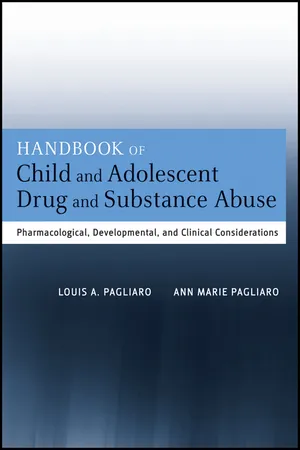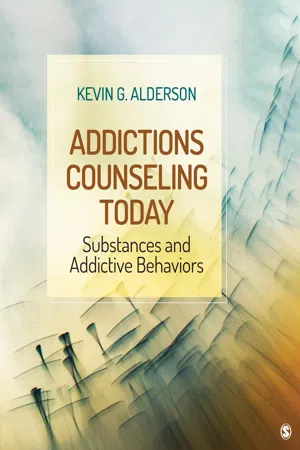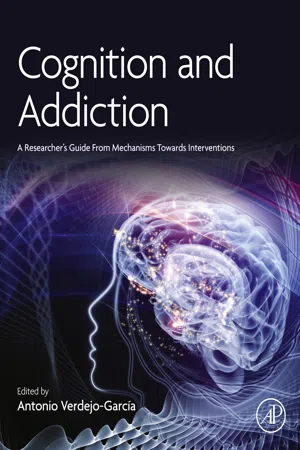Psychology
Nicotine Addiction
Nicotine addiction refers to the compulsive need for nicotine, a highly addictive substance found in tobacco products. It is characterized by physical dependence, withdrawal symptoms, and a strong craving for nicotine. This addiction can lead to serious health issues and is often challenging to overcome due to its powerful effects on the brain's reward system.
Written by Perlego with AI-assistance
Related key terms
6 Key excerpts on "Nicotine Addiction"
- eBook - ePub
- R. Loddenkemper, M. Kreuter(Authors)
- 2015(Publication Date)
- S. Karger(Publisher)
In the last 2 decades, significant progress has been made towards the development of a comprehensive understanding of various factors that underlie nicotine dependence and its treatment, such as vulnerability to addiction, outcomes of quit attempts, the role of genetics and the assessment of nicotine dependence. In addition, knowledge of the interaction of nicotine with nicotinic acetylcholine receptor (nAChR) subtypes, and the subsequent modulation of neurotransmitter systems that play a role in the addictive effects of nicotine, has further advanced. The elucidation of genetic factors influencing nicotine dependence is already shaping the clinical assessment and design of smoking cessation trials, along with factors underlying successful abstinence. The continued search for neurobiological mechanisms of nicotine dependence has uncovered several new targets for pharmacotherapeutic interventions, including a number of nAChR subtypes other than the predominant α4β2 nAChR, and various neurotransmitter systems. These efforts have revealed several new approaches for the treatment of nicotine dependence, which foreshadow more informed, targeted and effective interventions to curb the impact of the tobacco epidemic on public health and mortality.© 2015 S. Karger AG, BaselSoon after it was recognized that lung cancer and chronic bronchitis were causally related to cigarette smoking, nicotine and tobacco research concentrated on toxic components in tobacco smoke, as well as on the role of nicotine in tobacco addiction. In the Surgeon General’s Report series on smoking that started in 1964, the 11th report from 1979 defined for the first time smoking as a ‘Nicotine Addiction’, and by that time it became clear that smoking tobacco and inhaling nicotine is a form of nicotine self-administration that is very difficult to stop, leading to the current worldwide nicotine dependence pandemic. Since then, significant progress has been made in our understanding of the factors that determine vulnerability to addiction and the outcome of quit attempts, the role of genetics, the assessment of nicotine dependence and the interaction of nicotine with acetylcholine receptors that underlie nicotine dependence. Together, these advances resulted in the development of more effective treatments and the identification of novel biological targets (see also chapter 17 ). These topics are briefly discussed in this chapter, with references to recent comprehensive reviews and, where appropriate, to primary or recent literature.Classification of Nicotine Dependence
Nicotine dependence consists of three phases, each of which may have a unique neurobiological substrate: acquisition and maintenance of nicotine-taking behavior, withdrawal symptoms upon cessation of nicotine intake and vulnerability to relapse [1 - Barry Stimmel(Author)
- 2013(Publication Date)
- Routledge(Publisher)
An Analysis of the Addiction Liability of Nicotine Allan C. Collins, PhD Allan C. Collins is affiliated with the Institute for Behavioral Genetics and Department of Psychology, Campus Box 447, University of Colorado, Boulder, CO 80309. Dr. Collins is supported in part by a Research Scientist Development Award from the National Institute on Drug Abuse (DA-00116).SUMMARY. Even though the percent of adults who smoke has been reduced dramatically in the last 20 years, more than 50 million people continue to use tobacco on a daily basis. A majority of these people claim that they would like to stop smoking, but cannot. This review discusses the data suggesting that tobacco smokers are seeking nicotine. The behavioral effects elicited by nicotine and its relative reinforcing properties, as well as the development of tolerance to nicotine and the role of nicotine in the tobacco withdrawal syndrome are discussed. The data indicate that nicotine has addiction liability, but this liability is probably not equal to that of other agents such as cocaine and the opiates.INTRODUCTIONThe health consequences of smoking have received a great deal of attention from the medical community ever since the first Surgeon General’s Report on Smoking and Health. The 20th Report of the Surgeon General on the Health Consequences of Smoking (1988) is entitled “Nicotine Addiction.”1 The Report concludes that:• Cigarettes and other forms of tobacco are addicting. • Nicotine is the drug in tobacco that causes addiction. • The pharmacological and behavioral processes that determine tobacco addiction are similar to those that determine addiction to drugs such as heroin and cocaine.The Surgeon General’s Report is the most comprehensive review of the literature available today; the Report is over 500 pages long, and it reviews thousands of studies. Consequently, the present paper will not attempt to cover the entire literature. The reader is referred to the Surgeon General’s Report for this comprehensive review. Rather, this paper will focus on the primary issues related to the potential role of nicotine in regulating tobacco use, and will attempt to discuss some of the areas of dispute generated by the Surgeon General’s Report.- eBook - ePub
Handbook of Child and Adolescent Drug and Substance Abuse
Pharmacological, Developmental, and Clinical Considerations
- Louis A. Pagliaro, Ann Marie Pagliaro(Authors)
- 2011(Publication Date)
- Wiley(Publisher)
A decade later, Collins (1990) summarized the 20th Report of the Surgeon General on the health consequences of smoking, which was titled Nicotine Addiction. This summary, a 500-page comprehensive review of over 1,000 published studies, concluded that: (1) the use of tobacco products was associated with the development of physical dependence; (2) nicotine was the substance identified as causing the physical dependence in these products; and (3) the process of becoming physically dependent on nicotine 67 was similar to that observed for heroin and cocaine (p. 84). In addition, because the use of smokeless tobacco products can result in the same blood concentrations of nicotine as smoked tobacco products, the physical dependence observed from the use of smokeless products is the same. Since this time, it has been generally agreed that nicotine is the major component of tobacco smoke that is responsible for the observed physical dependence (Benowitz, 1999; Dani & De Biasi, 2001; Pagliaro & Pagliaro, 2009). Most of the earlier studies and related findings concerning nicotine dependence were conducted using adult samples. More recently, many of these studies have been replicated using adolescent samples (e.g., Caraballo, Novak, & Asman, 2009; Lessov-Schlaggar, Hops, Brigham, et al., 2008). In addition, it also has been found that infrequent smoking (i.e., as little as 1 cigarette per month), specifically among adolescents, may be associated with the signs and symptoms of nicotine withdrawal, particularly a strong desire to smoke (Doubeni, Reed, & DiFranza, 2010; Rose, Dierker, & Donny, 2010). Physical dependence also has been demonstrated among recent-onset adolescent smokers (Rose & Dierker, 2010). Tolerance The regular, long-term use of nicotine can result in the development of tolerance as occurs with many other drugs and substances of abuse (e.g., opiate analgesics; see Chapter 1, The Psychodepressants) - eBook - ePub
Addictions Counseling Today
Substances and Addictive Behaviors
- Kevin G. Alderson(Author)
- 2019(Publication Date)
- SAGE Publications, Inc(Publisher)
Smoking is now proven to cause a myriad of diseases and adverse health effects such as various cancers, chronic obstructive pulmonary disease (COPD), premature skin aging, impaired fertility, cataracts, and many more. Its social acceptability has decreased over the years due to countermarketing, leading to a lowered smoking prevalence (Gearhardt & Corbin, 2012). However, despite its dangerous effects, tobacco is still readily available to much of the adult population. Musk and De Klerk (2003) compared tobacco to asbestos, both of which have been used since ancient times and have been proven to cause serious disease. However, where asbestos is now strictly regulated and virtually eliminated, tobacco remains readily available.Nowadays, one can find tobacco in various forms, including cigarettes, cigars, chewing tobacco, e-cigarettes, hookah, water pipes, and roll-your-own cigarettes (Donaldson, Hoffman, Zandberg, & Blake, 2017). Still, the most prevalent form of use is the commercially produced cigarette (Brennan, Levesque, & Riley, 2016).Nicotine Addiction is an addiction to nicotine. It “occurs when smokers come to rely on smoking to modulate mood and arousal, relieve withdrawal symptoms, or both. Light or occasional smokers smoke mainly for positive reinforcement in specific situations” (Benowitz, 2010, p. 2301).West (2017) suggested that smoking is maintained by the positive and negative reinforcements of nicotine, its affordability and palatability, and the distance and uncertainty of its adverse health consequences. By itself, nicotine has poor reinforcing effects; however, tobacco products are designed to optimize the delivery of nicotine to central nervous system receptors and also promote conditioned learning through sensory cues (Alpert, Agaku, & Connolly, 2016).The sensory aspect of smoke inhalation is rewarding in itself due to a behavioral conditioning process (Patterson, Schnoll, & Lerman, 2011). Denicotinized cigarettes, for example, still result in smoking satisfaction and craving reduction. Similarly, researchers have proposed that “anticipated pleasure or satisfaction, the need to alleviate a nicotine-induced drive state and a stimulus-driven impulse” all play important roles in tobacco smoking (Wehbe, Ubhi, & West, 2018, p. 135). That being said, Wehbe et al. (2018) found in their study of 566 smokers attending treatment that almost half reported automatic urges to be dominant, whereas a substantial proportion of them did not anticipate pleasure or relief. - eBook - ePub
Cognition and Addiction
A Researcher's Guide from Mechanisms Towards Interventions
- Antonio Verdejo García(Author)
- 2019(Publication Date)
- Academic Press(Publisher)
There may be some overlap in the effects of nicotine and tobacco on mood and on cognitive performance. As mood is improved by smoking, there may be increased motivation to concentrate and perform well. Nicotine improves attention, especially in populations with poor baseline performance characteristic of some mental illnesses. Neuroimaging studies suggest that these cognitive effects may relate to enhancement of the executive control network (engaged by externally driven processes, e.g., a cognitive task), suppression of the default mode network (engaged by internally driven processes, e.g., while daydreaming), or a combination of both. Likewise, tobacco withdrawal may change the relationship between these two networks. If true, future research in this area ought to investigate how these networks can be manipulated to support tobacco cessation, via pharmacological or nonpharmacological (e.g., neurofeedback, transcranial magnetic stimulation) methods.It is difficult to understand why tobacco is so highly addictive, given its modest acute effects. The extent of classical conditioning (i.e., the number of times cigarette smoking is paired with another stimulus or experience) and the age of initiation play critical roles in the transition from occasional to daily smoking. Nicotine appears to enhance the motivation for other reinforcers as well, which is evident in the amount of effort expended to obtain other reinforcers when nicotine is physiologically present and in DA-rich mesolimbic brain activation when anticipating or receiving other reinforcers. Research in this area is important to understanding withdrawal-related anhedonia and the loss of motivation for nondrug rewards.As the smoking rates in the general population decline, there may be less concern or funding for tobacco addiction research. This may leave many vulnerable populations understudied and underserved. As tobacco addiction is a pervasive disease that interacts with and exacerbates other physical and mental illnesses, treatment for tobacco addiction should be an integral part of primary care medicine.References
Abdolahi A, Williams G.C, Benesch C.G, Wang H.Z, Spitzer E.M, et al. Damage to the insula leads to decreased nicotine withdrawal during abstinence .Addiction. 2015;110:1994–2003.Addicott M.A, Oliver J.A, Joseph McClernon F. Nicotine increases anterior insula activation to expected and unexpected outcomes among nonsmokers .Psychopharmacology (Berl.). 2017;234:1145–1154.Addicott M.A, Sweitzer M, McClernon F.J. The effects of nicotine and tobacco use on brain reward function: interaction with nicotine dependence severity .Nicotine Tob. Res. - Michael B. First, Allan Tasman(Authors)
- 2011(Publication Date)
- Wiley(Publisher)
Nicotine has stimulant and depressive effects on both the central and the peripheral nervous systems. It also affects the cardiovascular system, the gastrointestinal system, and the skeletal motor system. Nicotine stimulates the cholinergic nervous system (sympathetic and parasympathetic).Nicotine is a highly addictive substance that causes physical and psychological dependence that is similar to that of opiates and other substances of abuse. Smokers adjust smoking behavior to regulate and maintain the level of nicotine in the blood stream. A withdrawal syndrome develops in response to reduced intake or total abstinence and involves both physiological and psychological symptoms. Withdrawal symptoms overlap with those of alcohol and other substances of abuse.Psychological dependence on cigarettes involves the perceived benefits/reasons a person smokes, such as a perception that they are able to improve mood and sense of well-being, to satisfy craving, and to provide stimulation and relaxation. Through this variety of central and peripheral actions, nicotine improves mood and decreases anxiety; decreases distress in response to stressful stimuli and decreases aggression; improves overall cognitive function and performance (improves reaction time, concentration, vigilance, and stimulusprocessing capacity, increases attention, memory and learning, improves the ability to disregard irrelevant stimuli); and decreases the appetite for simple carbohydrates, decreases stress-induced eating, and increases resting metabolic rate. Many individuals soon become tolerant to these effects so that they smoke not to achieve them, but rather to avoid withdrawal symptoms. The direct beneficial effects of nicotine on mood and concentration become highly positive reinforcements, as do associated social context and behaviors linked with smoking, which then can act as powerful triggers for relapse during attempts at cessation. Individuals’ expectations related to smoking are influential factors that counter the obvious health risks. For women these beliefs are also in the context of sociocultural attitudes that reinforce the belief that smoking helps to manage and control mood (anger, stress, depression), control weight gain, and increase an adolescent’s sense of being independent and trendy.
Learn about this page
Index pages curate the most relevant extracts from our library of academic textbooks. They’ve been created using an in-house natural language model (NLM), each adding context and meaning to key research topics.





